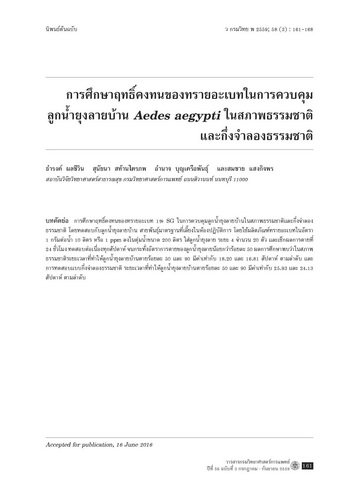The Persistence of Temephos (Abate) on Aedes aegypti L. Larvae Under Field and Simulated Conditions
Keywords:
Aedes aegypti L. larvae, Abate, persistence, LT50 and LT90Abstract
The persistence of larvicide product (Abate 1% SG) were evaluated for controlling Aedes aegypti L. larvae under field and simulated conditions. Laboratory strain of Ae. aegypti larvae were used in this study. Abate 1% SG was applied 1g per 10 liters of contained water or 1 ppm in a 200-litre jar. Twenty fourth-instar larvae of Ae. aegypti were added into the jar. Mortality of the larvae was recorded after 24 hours. Tests were performed continue weekly until the mortality rate of the larvae with less than 50% was observed. Results showed that under field conditions, the lethal times to kill 50% (LT50) and 90% (LT90) of the tested mosquitoes were 18.20 and 16.81 weeks, respectively while those LT50 and LT90 in simulated conditions were 25.93 and 24.13 weeks, respectively.
References
Bureau of Vector Borne Disease, Department of Disease Control, Ministry of Public Health. An Annual report of dengue cases 2015, Thailand. [online]. 2015 [cited 2015 Dec 31]; Available from URL: https://www.thaivbd.org/n/home
Morin CW, Comrie AC, Ernst K. Climate and dengue transmission: evidence and implications. Environ Health Perspect. 2013; 121(11-12): 1264-1272. [สืบค้น 31 ธันวาคม 2558]; [9 หน้า]. เข้าถึงได้ที่ URL: https://dx.dol.org/10.1289/ehp.1306556.
Thanispong K, Sathantriphop S, Chareonviriyaphap T. Insecticide resistance of Aedes aegypti and Culex quinquefasciatus in Thailand. J. Pestic Sci. 2008; 33(4): 351-356.
Chareonviriyaphap T, Bangs MJ, Suwonkerd W, Kongmee M, Corbel V, Ngoen-Klan R. Review of insecticide resistance and behavioral avoidance of vectors of human diseases in Thailand. Parasites & Vectors. 2013; 6: 280. [28 p.] [online]. 2013 [cited 2016 Jan 1]; Available from URL: https://www.ncbi.nlm.nih.gov/pmc/articles/PMC3850650/
Chareonviriyaphap T, Akratanakul P, Nettanomsak S, Huntamai S. Larval habitats and distribution patters of Aedes aegypti (Linnaeus) and Aedes albopictus (Skuse), in Thailand. Southeast Asian J. Trop. Med. Public Health. 2003; 34(3): 529-535.
Thongwat D, Bunchu N. Susceptibility to temephos, permethrin and deltamethrin of Aedes aegypti (Diptera: Culicidae) from Muang district, Phitsanulok Province, Thailand. Asian Pac. J. Trop. Med. 2015; 8(1): 14-8.
สุธรรม อารีกุล. บทปฏิบัติการกีฏวิทยาและโรคพืช. กรุงเทพฯ : บูรพาศิลป์การพิมพ์; 2010.
World Health Organization. Safe use of pesticides: ninth report of the WHO expert committee on vector biology and control. WHO technical report series 720. Geneva: World Health Organization; 1985.
Hassan AA, Salmah MRC, Ngumbang J, Ramli SA, El-badri AM. Mosquitoes of urban areas of Penang abundance and control. Proceedings of the fifth international conference on urban pests. 2005; 257-263.
Thavara U, Tawatsin A, Kong-ngamsuk W, Mulla MS. Efficacy and longevity of a new formulation of temephos larvicide tested in village-scale trials against larvae Aedes aegypti larvae in water storage containers. J. Am. Mosq. Control Assoc. 2004; 20(2): 176-182.
Abbott WS. A method for computing the effectiveness of an insecticide. 1925. J. Am. Mosq. Control Assoc. 1987; 3(2): 302-3.
Lek-Uthai U, Rattanapreechachai P, Chowanadisai L. Bioassay and effective concentration of Tmephos against Aedes aegypti larvae and the adverse effect upon indigenous predators: Toxorhynchites splendens and Micronecta sp. Asia Pac. J. Public Health 2011; 2(2): 67-77.
Mulla MS, Thavara U, Tawatsin A, Chompoosri J. Procedures for evaluation of field efficacy of slow release formulations of larvicides against Aedes aegypti in water storage containers. J. Am. Mosq. Control Assoc. 2004; 20(1): 64-73.
George L, Lenhart A, Toledo J, Lazaro A, Han WW, Velayudhan R, et al. Community-effectiveness of temephos for dengue vector control: a systematic literature review. PloS Negl. Trop. Dis. 2015; 9(9): e0004006. [22 p.].

Downloads
Published
How to Cite
Issue
Section
License

This work is licensed under a Creative Commons Attribution-NonCommercial-NoDerivatives 4.0 International License.


